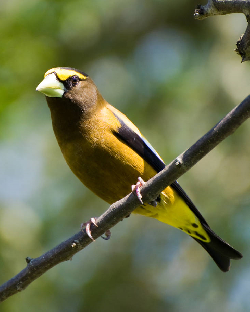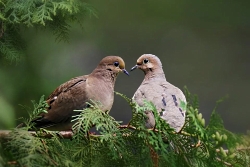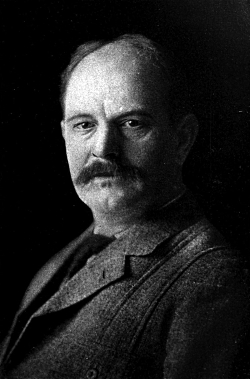
Courtesy US FWS
George Gentry, Photographer
The rules are simple; count all of the birds both seen and heard within a designated 15-mile diameter area over the entire day of the count which must be sometime between 14 December and 5 January. The result of these local and national counts now equates to a treasure trove of data. Every year since 1956 when the count started in Cache Valley, we observe around 90 species, though weather permitting we can see upwards of 100 species.
Data from these counts are valuable in documenting species like the Evening Grosbeak, a large vibrantly yellow-colored finch which migrates in large flocks. In the early days of the Christmas Bird Count, Evening Grosbeaks would migrate south in large numbers every few years from the Boreal Forests of Canada and the Northern U.S., to the point that they were observed in over 50% of the Christmas Bird counts across the U.S. In the late 1980’s however, their population size and ranges suddenly decreased drastically. In our data from the Cache Valley Christmas Bird Count we see this trend echoed with just 3 Evening Grosbeak observed in 1980 jumping to 119 seen the following year. That record was broken again though 2 years later and then shattered in 1987 with 721 Evening Grosbeaks seen on the single count date. The very next year the numbers plummeted with only 5 individuals seen. Numbers have since remained low until 2017 when we saw 282 Evening Grosbeaks. One theory about these dramatic fluctuations in population size and ranges is thought that it mirrors the abundance of their prey, spruce budworms. It is also hypothesized that deforestation and climate change play a role in these fluctuations of their population as well as their prey.
Observing these species and increasing this treasure of data is important for painting a picture of species movement and in addition, how species are responding to a changing climate locally and globally like the Evening Grosbeak. This massive data collection cannot be achieved by only scientists however, the participation of community members, like you and me, is necessary for not only the collection of more accurate data, but also for opening our own eyes to the natural world around us and getting to know the space that we occupy. Birding is a great way to connect to the outdoors and the Christmas Bird Count is the perfect excuse to get outside, especially this winter. Participation can be as simple as watching out your own window, joining a caravan, in separate vehicles this year to maintain social distance, or trekking through the snowy mountains from sunup to sun down. Visit Audubon.org to find a Christmas Bird Count near you to join this historic count.
I am Makenna Johnson with the Bridgerland Audubon Society and I am Wild About Utah!
Credits:
Photos: Courtesy US FWS George Gentry, Photographer
Audio:
Text: Makenna Johnson, Bridgerland Audubon Society and Graduate Student, Quiney College of Natural Resources, Utah State University
Additional Links: Makenna Johnson and Lyle Bingham, Bridgerland Audubon Society
Additional Reading
Info on Evening Grosbeaks received from:
Evening Grosbeaks, Bird Watching Daily, https://www.birdwatchingdaily.com/news/species-profiles/species-profile-evening-grosbeak/
Evening Grosbeaks, All About Birds, https://www.allaboutbirds.org/guide/Evening_Grosbeak/id
Check to see if you live within the count circle, then sign up to count today: Bridgerland Audubon Society, https://bridgerlandaudubon.org/
Greene, Jack, Christmas Bird Count 2019, Wild About Utah, December 9, 2019, https://wildaboututah.org/christmas-bird-count-2019/
Greene, Jack, Cache Valley Christmas Bird Count (CBC) and Climate Change, Wild About Utah, December 11, 2017, https://wildaboututah.org/cache-valley-christmas-bird-count-cbc-climate-change/
Liberatore, Andrea, Ruffed Grouse and the Christmas Bird Count, Wild About Utah, December 8, 2014, https://wildaboututah.org/ruffed-grouse-christmas-bird-count/
Cane, James, Kervin, Linda, The Christmas Bird Count, Wild About Utah, December 9, 2010, https://wildaboututah.org/christmas-bird-count/
Kervin, Linda, The Christmas Bird Count, Wild About Utah, December 16, 2008, https://wildaboututah.org/the-christmas-bird-count/
Greene, Jack, Climate Change and the Christmas Bird Count, Wild About Utah, December 12, 2008, https://wildaboututah.org/climate-change-and-the-christmast-bird-count/




